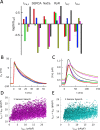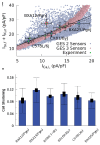The Ca2+ transient as a feedback sensor controlling cardiomyocyte ionic conductances in mouse populations
- PMID: 30251624
- PMCID: PMC6205808
- DOI: 10.7554/eLife.36717
The Ca2+ transient as a feedback sensor controlling cardiomyocyte ionic conductances in mouse populations
Abstract
Conductances of ion channels and transporters controlling cardiac excitation may vary in a population of subjects with different cardiac gene expression patterns. However, the amount of variability and its origin are not quantitatively known. We propose a new conceptual approach to predict this variability that consists of finding combinations of conductances generating a normal intracellular Ca2+ transient without any constraint on the action potential. Furthermore, we validate experimentally its predictions using the Hybrid Mouse Diversity Panel, a model system of genetically diverse mouse strains that allows us to quantify inter-subject versus intra-subject variability. The method predicts that conductances of inward Ca2+ and outward K+ currents compensate each other to generate a normal Ca2+ transient in good quantitative agreement with current measurements in ventricular myocytes from hearts of different isogenic strains. Our results suggest that a feedback mechanism sensing the aggregate Ca2+ transient of the heart suffices to regulate ionic conductances.
Keywords: cardiac electrophysiology; cardiac homeostasis; computational biology; mouse; physics of living systems; systems biology.
© 2018, Rees et al.
Conflict of interest statement
CR, JY, MS, AL, JW, AK No competing interests declared
Figures













References
-
- Bers D. Excitation-Contraction Coupling and Cardiac Contractile Force. Vol. 237. Springer Science & Business Media; 2001.
Publication types
MeSH terms
Substances
Grants and funding
LinkOut - more resources
Full Text Sources
Other Literature Sources
Medical
Molecular Biology Databases
Miscellaneous

